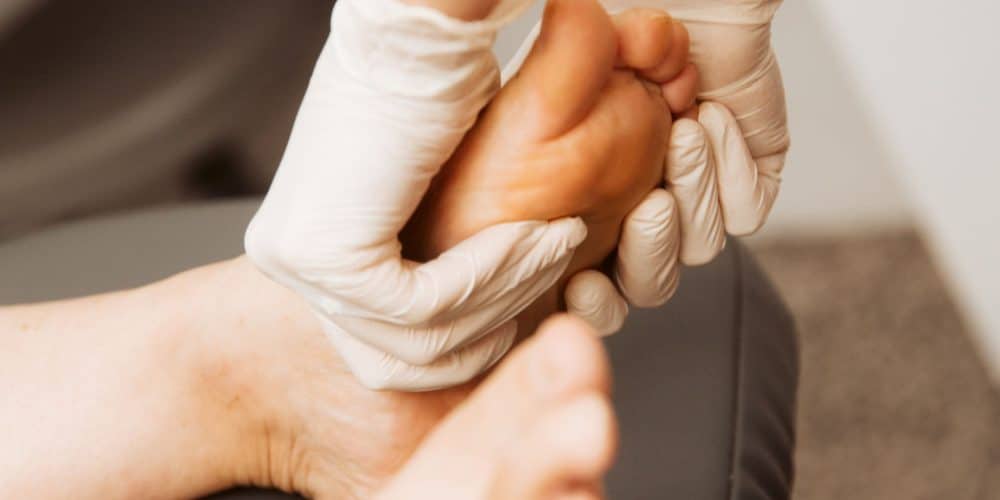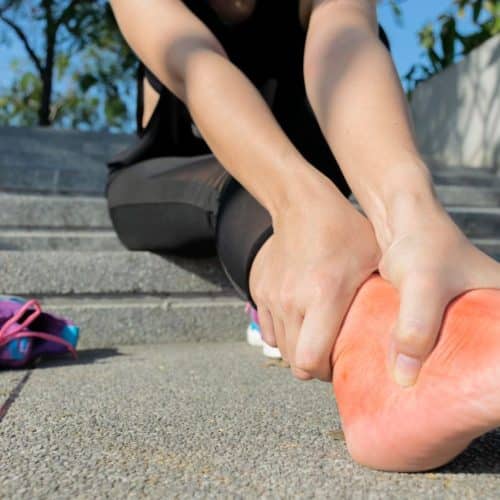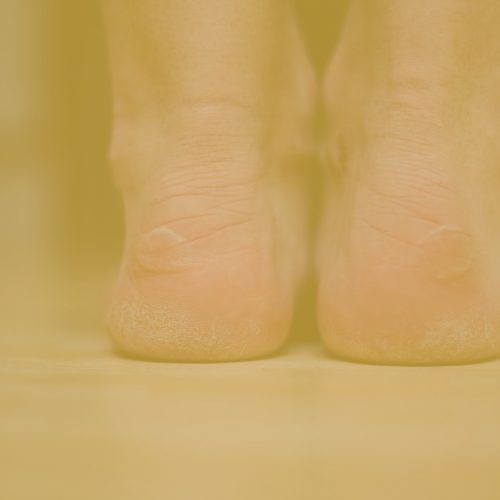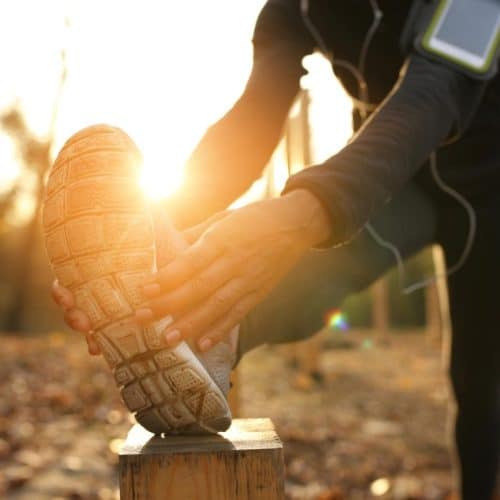Are you tired of dealing with persistent foot pain caused by plantar fasciitis? Looking for effective and simple ways to find relief? Well, you’re in the right place! This article will walk you through six easy-to-follow exercises to alleviate plantar fasciitis discomfort. Whether you’re an athlete, a fitness enthusiast, or someone who spends long hours on their feet, these exercises are perfect for all lifestyles. Say goodbye to foot pain and hello to a happier, more active life!
Understanding Plantar Fasciitis
Plantar Fasciitis is a prevalent and often painful foot condition affecting millions worldwide. To comprehend this condition better, let’s delve into its causes, symptoms, and how it impacts individuals.
1. What is Plantar Fasciitis?
The inflammation and irritation of the plantar fascia, a thick band of connective tissue found at the bottom of the foot, are the primary symptoms of plantar fasciitis, a disorder predominantly described by the condition.
This vital tissue helps to maintain the arch of the foot and absorbs shock when the foot strikes the ground during activities such as walking, jogging, and standing. The calcaneus, or heel bone, is connected to the toes by a connective tissue called the plantar fascia, which also ensures the foot’s structural soundness.
2. Causes of Plantar Fasciitis
Several factors can contribute to the development of Plantar Fasciitis, and understanding these causes can help individuals adopt preventive measures. Some of the common causes include:
- Overuse and Repetitive Stress: Running, dancing, and other activities that place an excessive amount of stress on the foot, such as staying on one’s feet for extended periods, can strain the plantar fascia, which can then lead to inflammation of the plantar fascia.
- Foot Mechanics: Abnormal foot mechanics, such as flat feet (pes planus) or high arches (pes cavus), can alter weight distribution and impact the plantar fascia, making it more susceptible to injury.
- Inadequate Footwear: Wearing shoes with inadequate support, insufficient cushioning, or improper fit can lead to biomechanical issues and increase the risk of Plantar Fasciitis.
- Age and Physical Factors: Plantar Fasciitis is more common in adults between 40 and 60. Factors like obesity, sudden weight gain, or a job requiring prolonged standing or walking can contribute to the condition.
- Tight Calf Muscles: Tightness in the calf muscles can pull on the Achilles tendon, affecting the tension in the plantar fascia.
3. Symptoms of Plantar Fasciitis
Plantar Fasciitis typically manifests through specific telltale signs, and recognising these symptoms can aid in early detection and prompt treatment. The primary symptoms include:
- Heel Pain: The hallmark symptom of Plantar Fasciitis is intense pain in the heel, particularly when taking the first steps after waking up in the morning or following long periods of rest. The pain may also intensify after prolonged standing, walking, or physical activity.
- Stiffness: Individuals with Plantar Fasciitis often experience stiffness and a feeling of tightness in the bottom of the foot, especially around the heel and arch area.
- Tenderness and Swelling: The affected area may become tender to the touch, and some individuals may notice mild swelling or redness.
- Discomfort with Flexing Toes Upwards: Trying to flex the toes upwards may cause pain in the plantar fascia.
It’s important to note that the intensity of symptoms can vary from person to person, and some individuals may experience more severe pain than others.
Individuals can be empowered to take proactive actions in treating and obtaining appropriate treatment for this usual foot problem by first understanding the nature of plantar fasciitis, its probable causes, and the symptoms that are telltale signs of the illness.
Importance of Exercise for Plantar Fasciitis
Plantar Fasciitis can be painful and debilitating, but incorporating targeted exercises into your daily routine can be crucial in managing the symptoms and promoting overall foot health. Let’s explore why exercise is essential for individuals suffering from Plantar Fasciitis and how it can significantly affect their recovery.
1. Benefits of Exercise
- Strengthening the Foot Muscles and Ligaments: Specific exercises can target the muscles and ligaments in the foot, including those connected to the plantar fascia. Strengthening these structures provides better support to the foot arch, reducing the strain on the inflamed fascia.
- Improved Blood Circulation: Regular exercise increases blood flow to the affected area. Improved circulation helps deliver essential nutrients and oxygen to the injured tissues, promoting healing and reducing inflammation.
- Enhanced Flexibility and Range of Motion: Stretching exercises are beneficial in enhancing the foot’s flexibility and range of motion. This increased flexibility can alleviate tension in the plantar fascia and decrease the risk of further injury.
- Pain Relief and Discomfort Management: Exercise triggers the release of endorphins, the body’s natural painkillers. As a result, regular physical activity can relieve foot pain and discomfort associated with Plantar Fasciitis.
- Improved Mobility: Individuals with Plantar Fasciitis may experience a limited range of motion due to pain and stiffness. Targeted exercises can help improve mobility, making it easier to perform daily activities without excessive discomfort.
2. Considerations Before Starting
Before embarking on an exercise regimen for Plantar Fasciitis, it’s essential to take some precautions to ensure safe and effective progress:
- Consult a Specialist: If you’re uncertain about which exercises suit your specific condition or experience severe foot pain, consult a podiatrist or physical therapist. They can provide personalised guidance and recommendations tailored to your needs.
- Start Gradually: Begin with gentle exercises that don’t put too much strain on the foot. As your foot becomes stronger and more accustomed to the exercises, you can gradually increase the intensity and duration.
- Listen to Your Body: How your foot responds to the exercises. Stop and rest if you experience increased pain or discomfort during or after an exercise. Pushing through intense pain may exacerbate the condition.
- Combine with Rest and Recovery: Exercise is essential to managing Plantar Fasciitis, but it’s equally crucial to allow sufficient time for rest and recovery. Avoid overloading your foot with excessive physical activity.
Easy Plantar Fasciitis Exercises
Plantar Fasciitis exercises are designed to stretch and strengthen the muscles and ligaments in the foot, alleviating tension on the plantar fascia and promoting healing. When performed regularly, these easy exercises can relieve pain and discomfort associated with Plantar Fasciitis. Let’s explore each exercise in detail:
1. Heel Stretch
- You should face a wall and lean on it with your hands for support.
- Take a step backwards with one foot while ensuring that your heel is on the ground and your toes are pointed forwards.
- Keep your rear leg completely straight as you gradually bend the knee of the front leg.
- You should feel a stretch at the back of the ankle and along the calf as you do this.
- While holding the stretch for thirty seconds and taking deep breaths.
- Alternate between your legs and extend the opposite side in the same manner.
- Two to three reps should be performed on each leg.
2. Toe Stretch
- Sit on a chair with one foot crossed over the opposite knee.
- Hold your toes with your fingers and gently pull them back toward your shin.
- You should feel a stretch along the bottom of your foot and the arch.
- Hold the stretch for 20-30 seconds, maintaining a steady breath.
- Switch to the other foot and repeat the stretch.
- Perform 2 to 3 repetitions on each foot.
3. Calf Raises
- Stand with your feet hip-width apart and your hands resting on a wall or a sturdy surface for balance.
- Slowly raise both heels off the ground, lifting your body weight onto the balls of your feet.
- Hold the raised position for a couple of seconds.
- Lower your heels back down to the ground with control.
- Repeat for 10-15 repetitions.
- For an added challenge, perform the calf raises on one foot at a time.
4. Achilles Tendon Stretch
- Place your hands on a wall as you face it and stand there.
- Take a step backwards with one foot while maintaining a straight leg and a flat heel.
- Keep your rear leg extended while bending your front knee.
- Leaning against the wall should result in a stretch running along the lower back of the leg.
- After holding the stretch for twenty to thirty seconds on one leg, move to the other leg and repeat.
- Two to three reps should be performed on each leg.
5. Towel Curl
- Sit on a chair with both feet flat on the floor.
- Place a small towel on the ground in front of you.
- Using your toes, scrunch the towel towards you, creating a gathering motion.
- Release the towel and repeat the scrunching motion.
- Perform 10-15 repetitions for each foot.
6. Marble Pick-Up
- Sit on a chair with a bowl of marbles on the floor before you.
- Use your toes to pick up one marble at a time and place it in another bowl.
- Continue until all the marbles have been transferred.
- This exercise helps improve toe mobility and strengthens the foot muscles.
Incorporating these easy exercises into your daily routine can make a significant difference in managing Plantar Fasciitis. Remember to perform them gently and avoid overexertion. Consistency is key to experiencing the benefits of these exercises, and combining them with other treatments, such as rest, ice, and proper footwear, can contribute to a faster recovery process.
Before starting any exercise program, it’s advisable to consult with a podiatrist or physical therapist, especially if you have severe foot pain or a history of foot-related issues. With regular practice and proper care, you can take positive steps towards relieving foot pain and enhancing your overall foot health.
Other Home Remedies for Relief
In addition to exercises, several effective home remedies can relieve Plantar Fasciitis and support healing. Combining these remedies with targeted exercises can help manage the condition and improve overall foot health. Let’s explore some of the most beneficial home remedies:
- Rest and Ice: One of the most crucial aspects of managing Plantar Fasciitis is giving your foot adequate rest. Avoid activities that aggravate the pain, and try to elevate your foot when resting to reduce swelling. Applying ice to the affected area for about 15-20 minutes several times daily can help alleviate inflammation and numb the pain.
- Proper Footwear: Wearing appropriate footwear is essential for individuals with Plantar Fasciitis. Opt for shoes that provide excellent arch support, cushioning, and stability. Avoid high heels, flip-flops, or shoes with inadequate support, as they can exacerbate the condition.
- Arch Support: Consider using orthotic devices or shoe inserts that provide additional arch support. These inserts can help distribute pressure evenly across the foot and reduce strain on the plantar fascia.
- Night Splints: Night splints are braces designed to keep the foot slightly stretched while you sleep. They help prevent the plantar fascia from tightening and can reduce morning pain and stiffness.
- Stretching and Massaging: Gentle stretching of the calf muscles and the plantar fascia can be beneficial. Regularly massaging the foot can also help increase blood flow to the affected area and promote healing.
- Over-the-Counter Pain Medications: Non-steroidal anti-inflammatory drugs (NSAIDs), such as ibuprofen, can help manage pain and reduce inflammation. However, it’s essential to consult a healthcare practitioner before using any medications.
- Weight Management: Keeping your weight at a healthy level will considerably cut down on the strain that your feet are under. The control of excess body weight is essential in treating plantar fasciitis because excess body weight can lead to increased pressure on the plantar fascia.
- Foot Stretches in the Morning: Before getting out of bed, perform gentle foot stretches to loosen the plantar fascia and reduce morning pain. This can include flexing and pointing your toes or using a towel to stretch the foot.
- Avoid Barefoot Walking: Walking barefoot or on hard surfaces can worsen the symptoms of Plantar Fasciitis. Consider wearing supportive footwear or slippers with cushioning around the house.
- Taping and Strapping: Some individuals find relief from taping or strapping the foot to support the plantar fascia. There are specific taping techniques that can be learned from a podiatrist.
Remember that every individual’s response to home remedies may vary, so your approach must be patient and consistent. If you experience persistent or worsening symptoms, consult a podiatrist for personalised advice and treatment options.
By combining these home remedies with exercises, you can create a comprehensive approach to managing Plantar Fasciitis and take an active role in promoting the healing and recovery of your foot.
When to Seek Professional Help
While home remedies and exercises can be beneficial for managing Plantar Fasciitis, there are instances when seeking professional help is essential for proper diagnosis and treatment. If you experience any of the following conditions or symptoms, it’s crucial to consult a podiatrist for expert advice and personalised care:
- Persistent Pain: If you have been experiencing foot pain due to Plantar Fasciitis for more than a few weeks, it’s time to seek professional evaluation. Prolonged pain can indicate an underlying issue that requires proper assessment and treatment.
- Limited Mobility: Difficulty walking or performing daily activities due to foot pain is a significant concern. If Plantar Fasciitis affects your mobility and hinders your ability to carry out regular tasks, medical attention is necessary.
- Increasing Intensity of Pain: If the pain associated with Plantar Fasciitis worsens over time, it may indicate a more severe condition or potential complications. Seeking professional help can help prevent further damage and improve recovery outcomes.
- No Improvement with Home Remedies: If you have diligently followed home remedies, exercises, and rest but see no improvement in your foot condition, it’s time to consult a podiatrist. They can conduct a thorough evaluation and recommend alternative treatment options.
- Symptoms in Both Feet: If you experience Plantar Fasciitis in both feet simultaneously, it may indicate an underlying systemic condition or biomechanical issue that requires professional assessment.
- Presence of Other Health Conditions: Individuals with certain health conditions, such as diabetes or rheumatoid arthritis, may have a higher risk of complications with Plantar Fasciitis. If you have pre-existing health conditions, seeking professional help is crucial for proper management.
- Recurring Plantar Fasciitis: If you have a history of Plantar Fasciitis and experience recurrent episodes, it’s essential to consult a podiatrist. They can identify potential risk factors and provide preventive measures to reduce the frequency of flare-ups.
- Severe Swelling or Redness: Experiencing severe swelling or redness in the foot may indicate infection or another underlying issue. Prompt evaluation by a podiatrist is necessary to prevent complications.
- Inability to Bear Weight on the Foot: If the pain is so severe that you cannot put weight on the affected foot, it’s crucial to seek immediate medical attention to rule out fractures or other serious injuries.
- Unexplained Foot Pain: If you are unsure of the cause of your foot pain, a podiatrist can perform a comprehensive evaluation to determine the underlying condition and provide appropriate treatment.
Remember, early diagnosis and timely intervention can improve outcomes and faster recovery from Plantar Fasciitis. A podiatrist can provide an accurate diagnosis, create a personalised treatment plan, and offer guidance on lifestyle modifications to prevent future occurrences of the condition. Don’t hesitate to contact a podiatrist with concerns or questions about your foot health.
Conclusion
In conclusion, these six easy plantar fasciitis exercises can be a game-changer for individuals seeking relief from foot pain. Plantar fasciitis can be a debilitating condition that hinders everyday activities and affects overall quality of life.
However, by incorporating these simple exercises into your daily routine, you can take significant steps towards alleviating discomfort and improving your foot health.
Remember, consistency is key when performing these exercises. Regularly dedicating a few minutes each day to these activities can make a substantial difference in your journey to recovery.
However, it’s essential to listen to your body and avoid overexertion. Consult a podiatrist for personalised guidance if you experience severe pain or discomfort while doing any of these exercises.
What other methods or techniques have you found effective in managing plantar fasciitis? Share your insights and experiences in the comments below to help others on their path to finding relief! Let’s create a supportive community to exchange valuable tips and strategies to conquer foot pain together!
Content Summary
- Whether you’re an athlete, a fitness enthusiast, or someone who spends long hours on their feet, these exercises are perfect for all lifestyles.
- Our top exercise recommendations include calf stretches, toe curls, foot massages, arch rolls, towel stretches, and ankle circles.
- With these exercises, you’ll strengthen the muscles in your feet, improve flexibility, and reduce inflammation.
- But these are just the starting steps on your journey to combat plantar fasciitis.
- Plantar Fasciitis is a prevalent and often painful foot condition affecting millions worldwide.
- Running, dancing, and other activities that place excessive stress on the foot, such as staying on one’s feet for extended periods, can strain the plantar fascia, leading to inflammation of the plantar fascia.
- Plantar Fasciitis typically manifests through specific telltale signs, and recognising these symptoms can aid in early detection and prompt treatment.
- The hallmark symptom of Plantar Fasciitis is intense pain in the heel, particularly when taking the first steps after waking up in the morning or following long periods of rest.
- Individuals with Plantar Fasciitis often experience stiffness and a feeling of tightness in the bottom of the foot, especially around the heel and arch area.
- Stretching exercises enhance the foot’s flexibility and range of motion.
- As a result, regular physical activity can relieve foot pain and discomfort associated with Plantar Fasciitis.
- If you’re uncertain which exercises suit your specific condition or experience severe foot pain, consult a podiatrist or physical therapist.
- Begin with gentle exercises that don’t put too much strain on the foot.
- As your foot becomes stronger and more accustomed to the exercises, you can gradually increase the intensity and duration.
- How your foot responds to the exercises.
- Stop and rest if you experience increased pain or discomfort during or after an exercise.
- Sit on a chair with one foot crossed over the opposite knee.
- Perform 2 to 3 repetitions on each foot.
- For an added challenge, perform the calf raises on one foot at a time.
- Place your hands on a wall as you face it and stand there.
- Incorporating these easy exercises into your daily routine can make a significant difference in managing Plantar Fasciitis.
- Consistency is key to experiencing the benefits of these exercises, and combining them with other treatments, such as rest, ice, and proper footwear, can contribute to a faster recovery process.
- In addition to exercises, several effective home remedies can relieve Plantar Fasciitis and support healing.
- Combining these remedies with targeted exercises can help manage the condition and improve overall foot health.
- One of the most crucial aspects of managing Plantar Fasciitis is giving your foot adequate rest.
- Keeping your weight at a healthy level will considerably cut down on the strain that your feet are under.
- By combining these home remedies with exercises, you can create a comprehensive approach to managing Plantar Fasciitis and take an active role in promoting the healing and recovery of your foot.
- While home remedies and exercises can be beneficial for managing Plantar Fasciitis, there are instances when seeking professional help is essential for proper diagnosis and treatment.
- If you have diligently followed home remedies, exercises, and rest but see no improvement in your foot condition, it’s time to consult a podiatrist.
- If you experience Plantar Fasciitis in both feet simultaneously, it may indicate an underlying systemic condition or biomechanical issue that requires professional assessment.
- Individuals with certain health conditions, such as diabetes or rheumatoid arthritis, may have a higher risk of complications with Plantar Fasciitis.
- If you have pre-existing health conditions, seeking professional help is crucial for proper management.
- If you have a history of Plantar Fasciitis and experience recurrent episodes, it’s essential to consult a podiatrist.
- Experiencing severe swelling or redness in the foot may indicate infection or another underlying issue.
- Prompt evaluation by a podiatrist is necessary to prevent complications.
- If the pain is so severe that you cannot put weight on the affected foot, seeking immediate medical attention is crucial to rule out fractures or other serious injuries.
- If you are unsure of the cause of your foot pain, a podiatrist can perform a comprehensive evaluation to determine the underlying condition and provide appropriate treatment.
- Remember, early diagnosis and timely intervention can improve outcomes and faster recovery from Plantar Fasciitis.
- Don’t hesitate to contact a podiatrist with concerns or questions about your foot health.
- In conclusion, these six easy plantar fasciitis exercises can be a game-changer for individuals seeking relief from foot pain.
- However, by incorporating these simple exercises into your daily routine, you can take significant steps towards alleviating discomfort and improving your foot health.
- Remember, consistency is key when performing these exercises.
- However, it’s essential to listen to your body and avoid overexertion.
- Consult a podiatrist for personalised guidance if you experience severe pain or discomfort while doing any of these exercises.
FAQs
1. Can I do these exercises daily?
Yes, performing these exercises daily can be beneficial, but start slowly and gradually increase the frequency.
2. How long does it take for the exercises to show results?
Results may vary, but consistency is key. Some people experience improvement within a few weeks, while others may take longer.
3. Can obesity cause Plantar Fasciitis?
Being overweight or obese can increase the risk of developing Plantar Fasciitis due to added pressure on the feet.
4. Are there any preventive measures for Plantar Fasciitis?
Yes, wearing proper footwear, maintaining a healthy weight, and stretching before exercise can help prevent Plantar Fasciitis.
5. Are there any specific shoes recommended for Plantar Fasciitis?
Shoes with good arch support and cushioning are recommended for individuals with Plantar Fasciitis.










